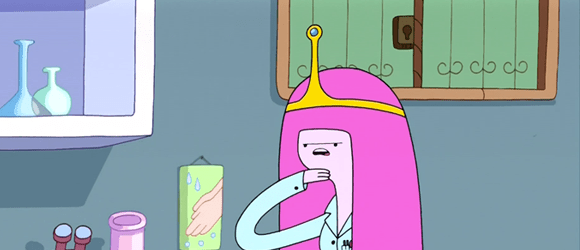Erika Ebbel Angle, host of the live science show “The Dr. Erika Show”, has two costume elements that should tell you everything you need to know; a lab coat, and her Miss Massachusetts tiara. The tiara in particular is a big hit with the studio audience of kids, most of them girls. Ebbel Angle, who is an MIT graduate with a Ph. D. in biochemistry, says the crown-and-labcoat pairing is meant to subvert what she feels is a stereotype about female scientists, and their presumed slovenly appearance. She wants to prove beauty and brains are possible for scientific women, and makes sure that the kids are getting the message.
But swinging too far to an emphasis on beauty is its own extreme stereotype, and Ebbel Angle’s show is seen by some as a case of protesting too much. If popular entertainment for the age group can be taken as a reasonable sample of our cultural mores, the show is speaking that language, and using it to make science more inviting. The “Princess Scientist” concept is tailored to its target audience of young girls, many of whom could be drawn to consider an area they had not otherwise. At the same time, it re-enforces an ideal of the smart, career-oriented woman who should also maintain a perfect physical appearance. It seems like, either way, there’s no winning. The real question becomes whether it is more important to appeal to impressionable would-be female scientists or enthusiasts, or to examine why this spectrum exists, and what can be done to change the perception of choices for the way women represent themselves.
The choices become more muddled – and, for some, more problematic – when the “Princess Scientist” concept is taken from children’s entertainment to pageant. Taking the anti-geek stereotype aim even further is Japan’s “Miss Rikei Contest”, a competition among university students and researchers based on the criteria of intelligence, “contributions to improving the image of science”, and beauty. Many professional researchers, in the US and abroad, when hearing of the contest’s existence, were disconcerted at the emphasis on appearance, and felt that it shouldn’t be emphasized any more than it is for male co-workers. It’s an age-old argument at this point, for sure. Does emphasizing appearance mean female professionals are taken less seriously? Or is it a necessary way to maintain place in a system that, in certain respects, is still stacked against women? Should getting ahead be achieved by any means? Or should more attention be paid to altering the judgement that makes this an issue at all? One thing’s for sure. There are no easy answers.
It could be said that a broader diversity of role models, including ones that are purposefully not outwardly ‘geeky’, or are examples of traditional feminine beauty, are needed to effectively get girls into the science fields. Call it the “do whatever it takes” approach. At the same time, a recent study at the University of Michigan for their journal of Social, Psychological & Personality Science found that “beauty-focused” role models actually discouraged girls who had not previously shown an interest in areas like science, engineering, or math. However, the same psychology researchers, Diana Betz and Denise Sekaquaptewa, were just as quick to point out a previous study done at the University of Washington, which showed that “geeky role models” can also discourage women who feel that they don’t identify with the image.
An ideal world would see room for not one side or another, but a way to expose the middle ground, and leave room for the many different kinds of positive role models that the community can offer to budding scientists. Betz and Sekaquaptewa said it best when asked about their assertions:
“On the surface, it might look like a ‘Damned if you’re feminine, damned if you’re not’ situation. But really, it’s about extremes: Role models should broaden examples of who can succeed in different fields, not limit them to one stereotyped image or another.”
(via LiveScience)








Published: Sep 7, 2012 02:41 pm